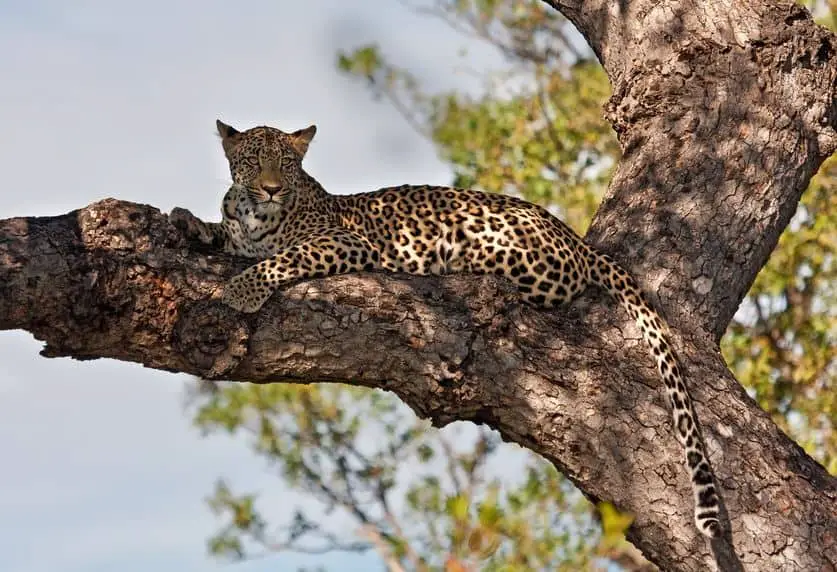
The leopard is one of the most elusive animals in Africa and if you are planning a Safari, or perhaps already out on one, there are some things you should know about to increase your chances of spotting a leopard.
So how do you spot a leopard in Africa? Leopards are primarily found in sub-Saharan Africa. They are nocturnal and mostly active at night so going for a morning game drive will increase your chances. During the day, keep an eye on the trees as leopards are often seen resting or eating in trees.
These are my three primary tips for finding the elusive leopard in Africa but there is, of course, much much more to it so keep reading to learn more.
1. Best Places to Spot Leopards in Africa
Leopards cannot be found all over Africa (at all actually) and while they are highly elusive animals and usually difficult to spot for humans, there are certainly places where leopards are more common than others. Let us take a look at some of these places.
African leopards are primarily found in the Sub-Saharan part of Africa and primarily inhabit savannas and rainforests as well as highly undisturbed areas with grassland and woodland.
Here are some specific examples of places where you have increased chances of spotting the elusive leopard.
- Kruger National Park, South Africa
- Etosha National Park, Namibia
- Masai Mara National Reserve, Kenya
- Serengeti National Park, Tanzania
- Moremi Game Reserve & Okavango Delta, Botswana
I have personally been fortunate enough to see African leopards in both Kruger National Park of South Africa and Etosha National Park of Namibia which is why I chose to place those at the very top of my list. I know for a fact that they work and I have the photos to prove it (although there are much nicer photos of leopards out there than what I have been able to get).
While doing my research for this post, Kenya, Tanzania, and especially Botswana kept showing up in the various articles, books, and other blog posts I found. I have seen leopards in both South Africa and Namibia multiple times, so those definitely work too.
The Kruger National Park covers roughly 20.000 sqm in the Mpumalanga and Limpopo provinces of South Africa and is one of the national parks with the richest animal life in the entire world.
Etosha National Park in the northern part of Namibia is unique and characterized by its flat, dry landscape and has a salt lake large enough to be seen from space. Despite this, it has an overwhelming number of animals of different varieties.
The Masai Mara National Reserve of Kenya is both famous for being a great place to spot the big cats of Africa and for being named after the Maasai people.
Serengeti National Park is found in Tanzania just east of Lake Victoria and is a favorite amongst tourists going on safaris. This national park is famous for its huge numbers of wildebeests and Zebras but is also home to the majestic and elusive leopard.
Botswana is also known to be a great safari destination and the Moremi Game Reserve and the Okavango Delta in the northern part of the country offers great variety in habitat and therefore also in the animal species that can be found.
Now that we know where to go to increase our chances of spotting the African leopard, let us take a look at some tips on how to spot it.

2. Leopards are Nocturnal so Go For a Morning Game Drive
Leopards are nocturnal animals and are primarily active during the night which is when most of their hunting is done.
Leopards can absolutely also be found during the day but to increase your chances, try being out as early as possible.
Whether you prefer solo drives or guided game drives with a professional ranger, a solid tip for increasing your chances of spotting the African leopard is to go for game drives in the morning. And by morning I mean very early morning. Ideally, you want to be in the car and on the dirt roads as the sun is rising as leopards will often still be active at this time.
Both guided game drives with a professional ranger and solo drives offer excellent advantages and I cannot recommend trying them both enough.
Game drives with professional rangers offer the obvious advantage of having someone with you who truly knows the area and the wildlife as well as how to spot it. In addition to this, rangers often communicate with each other so when one of them spots something significant, they will let others know about it. This will definitely increase your chances of spotting some great African wildlife including the elusive leopard.
While guided game drives are nothing short of awesome and I absolutely recommend trying those, I personally prefer solo drives as these allow you to go wherever you want, whenever you want, and stay there for as long as you want. You are completely on your own and do not have to respect anybody’s schedule other than your own. Solo drives can give you greater flexibility but they also require more skill, effort, and patience as not all African animals are easy to spot. Especially the leopard can be tricky.
I have personally been lucky enough to spot leopards on both guided game drives with professional rangers and solo drives and both were incredible experiences. While I personally enjoy solo drives more, the chances of spotting a leopard will most likely be higher if you go with a professional ranger.

3. Leopards Like to Stay in Trees so Look Up
Just like most other African mammals, leopards spend most of their time on the ground.
Something that makes the African leopard unique, however, is the fact that they also spend a significant amount of their time in trees. There are several reasons for this.
The leopard’s incredible strength and amazing climbing skills allow the big cat to carry kills even larger than the leopard itself up into trees where they can eat without being disturbed by other predators such as lions and hyenas.
In addition to this, the leopard’s ability to climb so well makes large tree branches the ideal place for the elusive cat to rest and sleep and take advantage of a cool breeze.
Another huge advantage the leopard has from being able to climb so well is that trees can provide safety and a way of escaping other predators such as African wild dogs, lions, or hyenas that may be chasing the leopard.
The color and pattern of the leopard’s fur provide it with excellent camouflage in the African landscape. A specific trick for spotting leopards in trees is to look for their tail hanging from the branches as they can stand out and look “smoother” than the actual branches of the tree as well as sometimes dangle from side to side.
So in addition to searching in the right places in Africa and going on game drives at the right time of the day, with or without a professional ranger, keep an eye on the trees because if you are lucky you can spot a leopard in a tree either sleeping or resting or if your are very lucky eating or even carrying its prey up into a tree.
